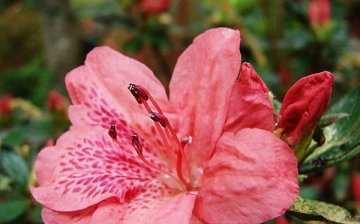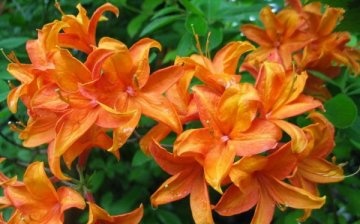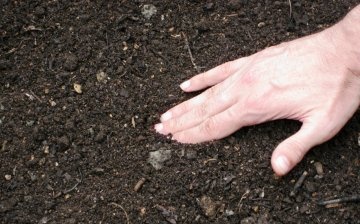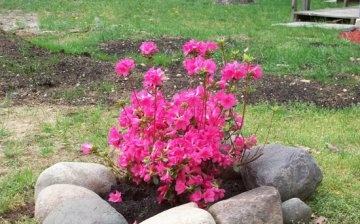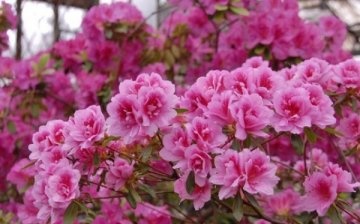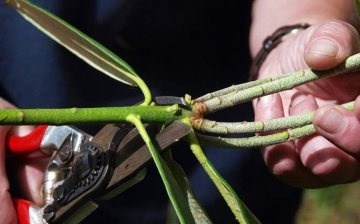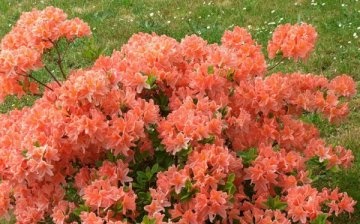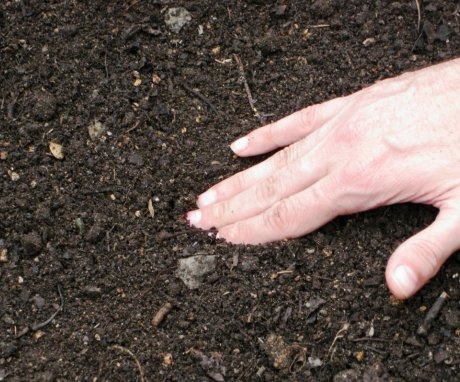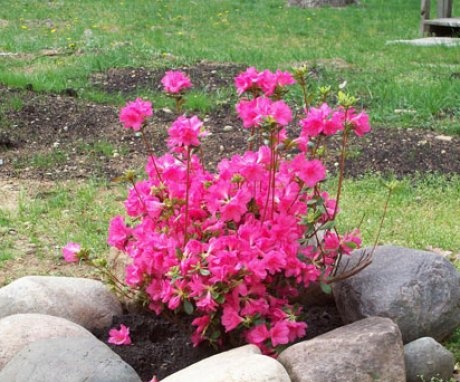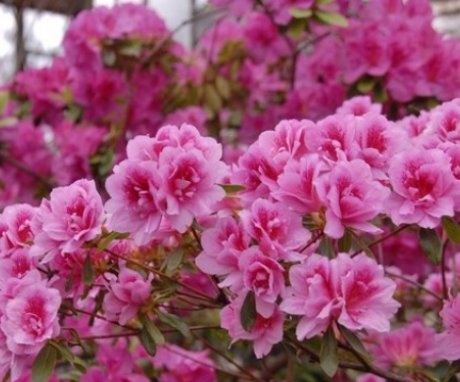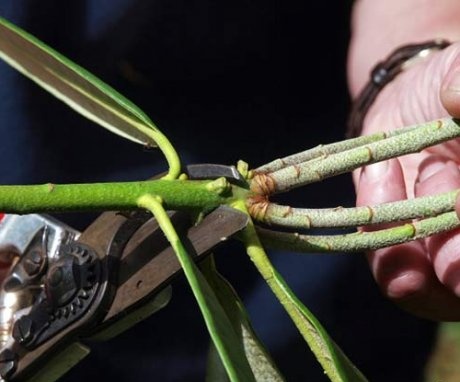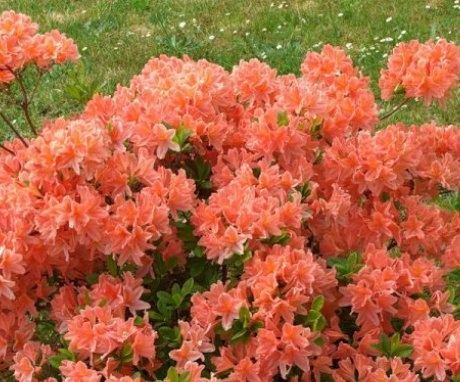Features of growing garden azalea
Azalea is a shrub from the heather family of the genus rhododendrons. The flower symbolizes passion in eastern countries. Evergreen shrubs ranging in size from half a meter to one and a half meters have small, dark green foliage, slightly pubescent. During flowering, the bushes are decorated with simple or double flowers of a rich color range. The flowering period occurs in November-April and lasts 1.5-2 months.
Large flowers of various colors emphasize favorably small dark foliage, which can be completely hidden by color. Flowers can be double or simple, with petals arranged in one or two rows. In its natural environment, the plant can be found in European, Asian and North American countries. Initially, azalea was grown in indoor or greenhouse conditions as a winter flowering ornamental shrub. And at the beginning of the twentieth century, breeders bred winter-hardy varieties suitable for planting in open ground in the garden.
Content:
- Types and varieties of garden azalea
- Preparing seedlings and planting sites
- Landing dates and rules
- Azalea garden care
- Reproduction
- Diseases and pests
Types and varieties of garden azalea
The ancestors of all known varieties are two types of garden azalea:
- Azaleas Indian or Sims rhododendrons. These are medium-sized leaf-shedding shrub-like plants growing up to half a meter. Young branches and leaves are covered with chestnut or reddish villi. Bushes are covered with small leathery leaves up to 4 centimeters in length. The leaf plate is green, with the inside being lighter than the outside. Indian Azaleas bloom with multi-colored simple or double flowers, which are collected in inflorescences. The color scheme ranges from pure white to bright scarlet shades. Flowers are often two-toned.
- Japanese azalea or rhododendron blunt. Japanese or evergreen azaleas are usually grown in the garden because they are more cold-hardy, able to withstand temperatures as low as 20 degrees. These are medium-sized, spreading bushes that begin to bloom in May. This species is distinguished by larger glossy leaves up to five centimeters in diameter and smaller multi-colored funnel-shaped flowers up to three centimeters.
Common varieties:
- Esprinzessin (Azalea japonica Eisprinzessin) - the height of the bush is up to 30 cm, and the diameter of the crown reaches half a meter. It blooms in May-June in double open white flowers with a pinkish center.
- Kermesina Rose - mature bushes reach 80 centimeters in height and a meter in width. The bell-shaped flowers of the variety have a two-color color: bright pink with burgundy blotches. The petals have a lighter edging. Time flowering May June.
- Kermesina Alba (Kermesina Alba) - differs from the previous variety in milky white flowers that abundantly cover the bush during flowering.
- Adonis is a descendant of mountain azaleas that bloom in May. Covered with glossy elliptical olive-colored leaves, the shrub blooms with snow-white flowers, collected in inflorescences. Azalea Adonis grows rather slowly and lives up to 10 years.
- Geisha Orange - bush height up to 50 cm, and width up to 70 cm.Bell-shaped orange flowers are concentrated at the tips of the branches. Flowering time May-June, duration 2-3 weeks. The crown of the shrub consists of many short shoots that are covered with dark leathery leaves.
- Toreador (Toreador) - one of the most spectacular rhododendrons, which is distinguished by bright purple flowers and bright glossy leaves. This is a semi-evergreen shrub that sheds old foliage, leaving young leaves. A bullfighter can grow up to a meter in height.
- Konigstein (Koenigstein) - has a round-compact crown of green foliage. The bush reaches a height of 0.8 m and a diameter of 1.2 m. The flowers have a lilac hue and densely cover the plant. Blooms in mid-May.
- Goldtopas (Goldtopas) - low bushes with beautiful bell-shaped flowers of bright yellow shades.
- Raimund (Raimunde) - blooms with strong-smelling pink flowers with orange spots. Blooms late.
- Sunte Nectarine - flowers collected in inflorescences resemble a shaggy golden ball with red strokes. Each individual flower consists of orange wavy petals surrounding a red corolla.
Preparing the seedling and planting site
For a garden azalea, a slightly shaded place in the garden is ideal, because the plant in nature prefers to grow in mountain woodlands. When choosing seedlings, the following points should be considered:
- the earthen lump should be moist and large enough. If there is not enough substrate, then root system can easily get hurt when transplante in the ground
- the branches should have a healthy appearance, and the plant itself should sit firmly in the ground
- it is better to purchase seedlings in a specialized store, then information about the variety and features is attached to the purchase landing and leaving
Before planting, the plant should be watered abundantly so that it can be easily removed from the container.
Garden azalea prefers loose acidic soil, consisting of coniferous or turfy soil with an admixture of peat and sand.
To keep the acidity of the soil at the desired level, you should periodically add a little citric acid to the irrigation water. Also, the soil must have a good cultivation capacity and at the same time retain moisture.
Landing dates and rules
The azaleas are planted in late spring, but seedlings can also be planted throughout the summer and during the warmer months of autumn. The plant has a superficial root system. In this regard, you should not plant shrubs near trees.
When planting, care should be taken that the root collar is not buried in the soil. Disembarkation should be carried out, adhering to some rules:
- the landing hole should be 60x60 cm in size
- at the bottom of the hole, drainage from fine gravel or broken brick is laid with a layer of 20 cm
- fill the hole with a soil mixture prepared in advance
- a seedling is placed in the center of the hole, sprinkled with a substrate and tamped a little
- abundant watering plants
- after shrinkage of the earth, the soil mixture should be poured into the hole without burying the neck of the plant
- the ground around the trunk is mulched with peat or moss
It must be remembered that the garden azalea loves space, so it is necessary to maintain sufficient spacing between the bushes.
Azalea garden care
Azalea is quite capricious in leaving and requires special attention. Garden azaleas are very fond of water. Besides regular glaze, should arrange shower shrubs. It is impossible to bring the soil to dryness, but overflows will not be beneficial to the plant. Azaleas require a special abundance of moisture during the period flowering... Also, plants should not be sprayed at this time, because moisture leaves ugly spots on the flower petals, which spoil the decorative effect.
Important! If the soil in which the azaleas grow dries up at least once, then the plant will drop not only all the blossoming flowers, but also the ovaries.
To provide plants with the necessary complex of minerals, it is necessary to carry out top dressing solution of cow dung. This fertilizer should be applied exclusively in the spring.
The next plant feeding is carried out after the end of the flowering period. At this stage, azaleas need potassium-phosphorus fertilizers to recuperate. For adult representatives, complex fertilizers with a long period of action will also be appropriate. You can not make top dressing directly under the roots, you need to distribute the compounds around the bush.
Cropping:
- Pruning bushes are carried out during the ejection of buds, removing all new shoots. This must be done so that the plant has enough strength to bloom.
- During and after flowering, dried buds and weakened stems should be removed.
- It is also worth thinning the bushes by removing densely growing branches. Thanks to such procedures, the bushes will acquire a neat decorative look for the next year.
To prepare azaleas for winter frosts, deep pruning of the bushes is carried out, in which all weak shoots are removed, and the remaining branches are shortened by a third.
After pruning, the plants should be covered with coniferous spruce branches, which will provide protection not only from the winter cold, but also from the early spring sun, which can destroy azaleas. Before sheltering, the bushes should be shed well and this should be done before the first frost.
Reproduction
There are three ways to propagate garden azalea:
- Seed method. The longest way. Plants are planted in the ground only the next year after sowing. seed... The seed is sown in greenhouses and germinate in the prepared soil, the grown seedlings are planted in separate containers.
- Cuttings... For this, a developed stalk with two or three leaves is separated. The place of the cut is treated with a growth stimulant and the cutting is placed in the peat mixture at an inclination of 45%. From above, the cuttings are covered with polyethylene material. Further care consists in regular watering and spraying.
- Division of the bush. In the spring, the bushes are neatly divided in half. Both halves must have a developed root system and at least two shoots. the separated plants are planted.
Diseases and pests
Like all representatives of the fauna, azaleas not immune to defeat diseases and pests... The most common ailments are: powdery mildew, rust and gray rot, and pests - various mites, whiteflies and azalea moths.
For the treatment of plants and the extermination of insects, insecticidal agents are used, which can be purchased at flower shops.
In conclusion, we can add that winter-hardy varieties of garden azaleas can be purchased exclusively in winter - this is a small bush up to 25 cm tall with young buds on the shoots.
Although the azalea is capricious in some ways, it is effectively able to decorate the garden in gratitude for the attention and consideration of its needs.
More information can be found in the video:



